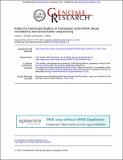Roles for transcript leaders in translation and mRNA decay revealed by transcript leader sequencing
Author(s)
Arribere, Joshua Alexander; Gilbert, Wendy
DownloadGilbert_Roles for transcript.pdf (1.503Mb)
PUBLISHER_CC
Publisher with Creative Commons License
Creative Commons Attribution
Terms of use
Metadata
Show full item recordAbstract
Transcript leaders (TLs) can have profound effects on mRNA translation and stability. To map TL boundaries genome-wide, we developed TL-sequencing (TL-seq), a technique combining enzymatic capture of m[superscript 7]G-capped mRNA 5′ ends with high-throughput sequencing. TL-seq identified mRNA start sites for the majority of yeast genes and revealed many examples of intragenic TL heterogeneity. Surprisingly, TL-seq identified transcription initiation sites within 6% of protein-coding regions, and these sites were concentrated near the 5′ ends of ORFs. Furthermore, ribosome density analysis showed these truncated mRNAs are translated. Translation-associated TL-seq (TATL-seq), which combines TL-seq with polysome fractionation, enabled annotation of TLs, and simultaneously assayed their function in translation. Using TATL-seq to address relationships between TL features and translation of the downstream ORF, we observed that upstream AUGs (uAUGs), and no other upstream codons, were associated with poor translation and nonsense-mediated mRNA decay (NMD). We also identified hundreds of genes with very short TLs, and demonstrated that short TLs were associated with poor translation initiation at the annotated start codon and increased initiation at downstream AUGs. This frequently resulted in out-of-frame translation and subsequent termination at premature termination codons, culminating in NMD of the transcript. Unlike previous approaches, our technique enabled observation of alternative TL variants for hundreds of genes and revealed significant differences in translation in genes with distinct TL isoforms. TL-seq and TATL-seq are useful tools for annotation and functional characterization of TLs, and can be applied to any eukaryotic system to investigate TL-mediated regulation of gene expression.
Date issued
2013-04Department
Massachusetts Institute of Technology. Department of BiologyJournal
Genome Research
Publisher
Cold Spring Harbor Laboratory Press
Citation
Arribere, J. A., and W. V. Gilbert. “Roles for transcript leaders in translation and mRNA decay revealed by transcript leader sequencing.” Genome Research 23, no. 6 (June 1, 2013): 977-987.
Version: Author's final manuscript
ISSN
1088-9051